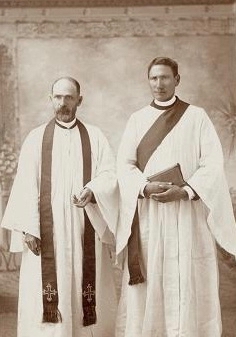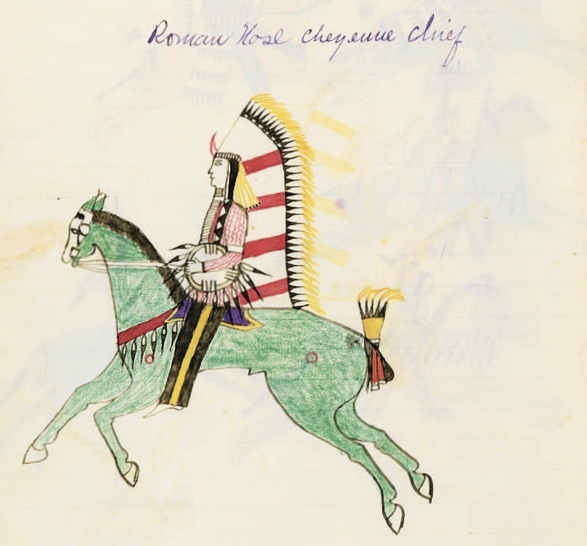
LIFE AS MYTH
![]()
JOURNAL
![]()
JOURNAL 2018
![]()
Mary & Co.
What we might be
![]()
SUMMER 2018
The power of unanswered prayer
![]()
LIFEWORKS
![]()
ATLAS
![]()

SUMMER 2018
MYTHOLOGY OF OTHER
Duplicate cast of "O-kuh-ha-tah," Making Medicine, Cheyenne warrior (from the article cited below). Courtesy of President and Fellows of Harvard College, Peabody Museum of Archaeology and Ethnology, PM# 78-1-10/13859. Created during his incarceration as a POW at Fort Marion (St. Augustine, Florida)
THE LESSON IN THE CHERRY BLOSSOM
Only a caricature Cartesianism would imagine a head, compartmentalized away from the disease, talking about the sick body beneath it. The head is tied to that body through pathways that science is only beginning to comprehend, but the general principle is clear: the mind does not rest above the body but is diffused throughout it.
Arthur W. Frank, The Wounded Storyteller: Body, Illness, and Ethics, Second Edition."I think -- therefore, I am" -- a fundamental premise of French philosopher René Descartes. But what is 'thinking' exactly? Is it only the function of our brains? Are brains and minds the same thing? Arthur Frank asserts that the mind is something more, that the mind and the body are not separate, but intimately interwoven. In other words, the act of thinking involves multiple spheres, including the body. Taking this one step further, there is reason to believe that the thinking mind, inhabiting both brain and body, may even transcend the boundaries of present time.
Consider a cherry blossom. The researchers at Emory University did. They reported that laboratory mice could inherit a cherry blossom phobia from their ancestors. Following intense negative associations with the smell of cherry blossoms in the lab, chemical processes in the brains of mice immediately altered genetic material within their DNA to carry that trait. Subsequent generations of mice, stimulated only by the sense of smell, displayed traits consistent with the cherry blossom phobia of their ancestors. Scientists have speculated that this experiment might begin to explain the emergence of unexplained phobias and anxiety in humans, humans who now carry the embodied memories of trauma from their ancestors.
I think -- therefore I am. Yes. But are our minds not only intimately linked to our bodies, but to our ancestors and their thoughts and lives and experiences as well?
Now pause and think. Consider your life, the lives around you, the beautiful beastly world we inhabit. What larger truth might the cherry blossom be trying to teach us?
(left) David Oakerhater Pendleton (standing on right), known as the artist "Making Medicine", pictured here after his release from prison, serving as a deacon in the US Anglican church. After his death he became an Anglican saint and has an observance included in the Lesser Feasts and Fasts.
(below) Ledger Drawing, Cheyenne Buffalo Chase, David Oakerhater Pendleton known as the artist "Making Medicine" created during his incarceration as a POW at Fort Marion (in St. Augustine, Florida). Massachusetts Historical Society.
"To encounter these remarkably detailed faces today is to encounter the people themselves, and how they appeared at the precise moment when their faces became someone else’s property."
‘Their Spirits Were Trapped in Those Masks’ Avi Steinberg, TOPIC. https://www.topic.com/their-spirits-were-trapped-in-those-masks
Many Native Americans imprisoned at Fort Marion (Florida) during the 19th Century generated "ledger art", so called when artists used lined ledger pages rather than more traditional Native American art materials (e.g. buffalo hide). The new materials allowed for greater detail and accuracy. Originally artists centered their work on themes of warfare, heroism, and courtship. However, over time, Native American artwork began reflecting a changing communal life due to displacement and the influence of white western culture.
One aspect of Fort Marion imprisonment was the creation of "life masks". Life masks and death masks were popular during the 19th Century and the life masks of Native American POWs were a Smithsonian commission obstensibly meant to capture the faces of peoples on the verge of extinction. Since they were a Smithsonian commission they are not covered under the 1990 Native American Grave Protection and Repatriation Act. NAGPRA is legislation that provides requirements for the return of Native American artifacts to tribes and/or descendants.



